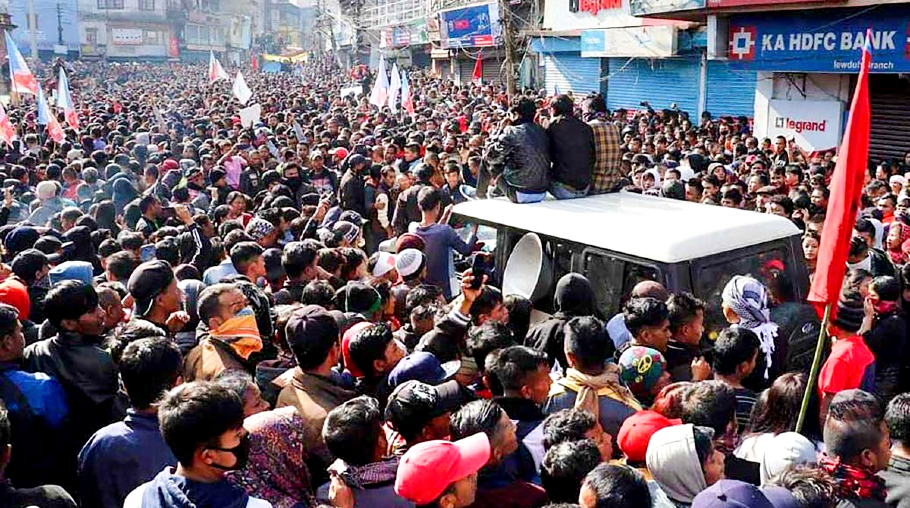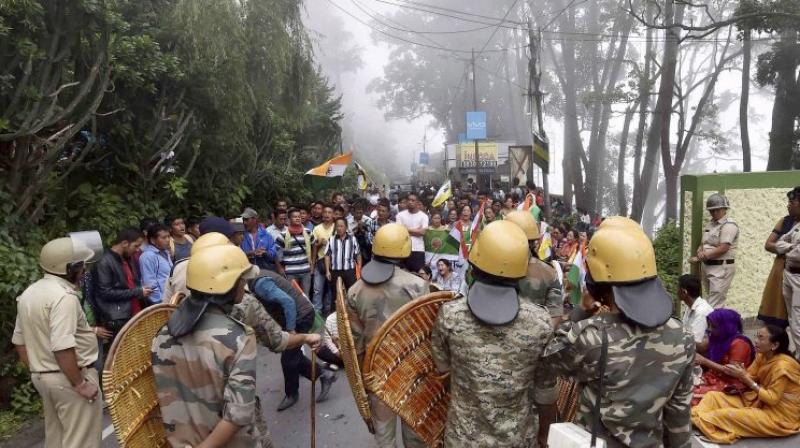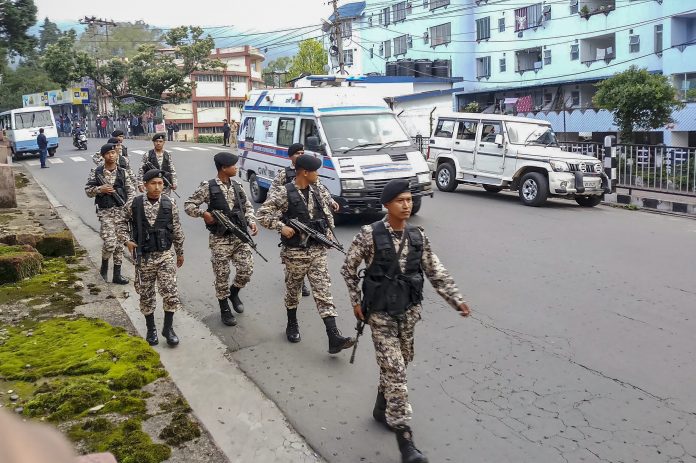
- Home
- News
- Analysis
- States
- Perspective
- Videos
- Education
- Entertainment
- Elections
- World Cup 2023
- Features
- Health
- Budget 2024-25
- Business
- Series
- NEET TANGLE
- Economy Series
- Earth Day
- Kashmir’s Frozen Turbulence
- India@75
- The legend of Ramjanmabhoomi
- Liberalisation@30
- How to tame a dragon
- Celebrating biodiversity
- Farm Matters
- 50 days of solitude
- Bringing Migrants Home
- Budget 2020
- Jharkhand Votes
- The Federal Investigates
- The Federal Impact
- Vanishing Sand
- Gandhi @ 150
- Andhra Today
- Field report
- Operation Gulmarg
- Pandemic @1 Mn in India
- The Federal Year-End
- The Zero Year
- Premium
- Science
- Brand studio
- Home
- NewsNews
- Analysis
- StatesStates
- PerspectivePerspective
- VideosVideos
- Entertainment
- ElectionsElections
- Sports
- Loading...
Sports - Features
- Budget 2024-25
- BusinessBusiness
- Premium
- Loading...
Premium

Meghalaya: How CAA reignited the ethnic cauldron
In the wake of the recent violence in Meghalaya triggered by the anti-CAA protests, the fact remains that the perceived threat to tribal rights in Meghalaya is often amplified, as their interests are well protected by job reservation and land rights.

Dkhar in Khasi means a foreigner. But now in Meghalaya, it is often used derogatorily to refer to all non-tribals. So, in 1979 when the Khasi Students Union (KSU), inspired by the anti-foreigner agitation of All Assam Students Union (AASU), launched the Beh Dkhar (chase away foreigners) movement, the target was Bengalis, who first started settling in picturesque Shillong, which was then...
Dkhar in Khasi means a foreigner. But now in Meghalaya, it is often used derogatorily to refer to all non-tribals. So, in 1979 when the Khasi Students Union (KSU), inspired by the anti-foreigner agitation of All Assam Students Union (AASU), launched the Beh Dkhar (chase away foreigners) movement, the target was Bengalis, who first started settling in picturesque Shillong, which was then the capital of undivided Assam, in the late 19th century as part of the British babudom.
Ousting so-called foreigners from the hill state has been a constant demand of the indigenous tribes since then.
The Beh Dkhar agitation forced as many as 20,000 Bengalis to leave the state, according to one estimate.
Governor Tathagata Roy on Friday (March 6) claimed that the status of the non-tribals in the state was akin to that of Kashmiri Pandits in 1991 when they had to flee their home state.
Last week, the state was caught in the ethnic swirl yet again, after the anti-CAA protest ended up in a clash between the tribals and non-tribals.
When curfew was lifted in Shillong on Sunday after weeklong unrest, shops and marketplaces continued to remain shuttered. Iewduh, more famous by its nickname Bara Bazar, the epicentre of the violence, too remained totally shut, showing no sign of normalcy. But this is a common scene on Sundays in this predominantly Christian state.
The East Khasi Hills deputy commissioner M War Nongbri told newspersons that the curfew was lifted as the law-and-order situation had improved. But a non-tribal businessman, who owns a garment shop in the city’s iconic Police Bazar, said over the phone, the actual assessment of the situation could be made only after markets reopened on Monday, wondering, even if normalcy returned, how long it would last.
History of violence
That is the nagging question gnawing at everybody’s mind given the state’s troubled history of periodically exploding into an ethnic frenzy since October 1979.
Even during the relatively peaceful phase, stray incidents of attack on non-tribals have been common. In 2013, within a span of a few months, two businessmen were set ablaze in two different places of the city. Trader Vikash Nandwal was seated at the cash counter of his shop, Meghalaya Machineries at Motphran on October 9, when a group of miscreants, allegedly also comprising members of KSU, set him on fire pouring petrol over him. He later succumbed to the severe burns. Barely a month later, on November 16, Bisheshwar Das, owner of Babua tea stall at Bishnupur Bazaar, was also set on fire in the same manner. Among the accused arrested over the incident, two were members of the KSU.

Apart from these heinous attacks, non-tribal businessmen are also regularly extorted by various influential social organisations as well as militant groups of the state.
“In Meghalaya, violence has become a form of communication. The protracted attacks that have happened since 1979 are a way of setting boundary markers from those that ‘don’t belong.’ It’s a soap opera where the wounds are never allowed to heal because there has never been any sincere attempt within communities to bridge the distances and allay the fears and suspicions. Meghalaya has not produced leaders to walk this difficult path because ethnocentric politics is still the most cashed-in currency in the political economy,” wrote Patricia Mukhim, a prominent social activist and writer of the state, in one of her columns in the Shillong Times, on March 6.
Ethnic fault line
“The domination of business establishments, labour force and other non-government employment opportunities by non-tribal settlers, who are mainly economic migrants from other parts of India is at the root of the social tension,” said Dipankar Roy, executive editor of the Shillong Times.
In the areas bordering Bangladesh instances of influx of illegal migrants from across the border too aggravated the fault line, Roy added.
This perceived threat to tribal rights is, however, often amplified, as their interests in the state are well protected by job reservation and land rights. In Meghalaya, 80 per cent government jobs are reserved for the state’s indigenous tribes. The non-tribals are not even allowed to purchase land or house outside a small pocket called European Ward, in the heart of the capital Shillong.
Given the fragile social makeup, the passage of the Citizenship (Amendment) Act by the parliament in December rekindled the apparent fear of indigenous communities being swarmed by Hindu migrants from Bangladesh for whom Indian citizenship norms have been relaxed by the contentious legislation.

Even before it was enacted, along with other north-eastern states, Meghalaya has been witnessing protests over the new law, demanding that the state be kept out of its purview by introducing Inner Line Permit (ILP) regime, which provides for the protection of indigenous communities by requiring non-residents to take a time-bound travel permit document (akin to visa). The CAA is not applicable in states under the ILP regime. Incidentally, almost 97 per cent of the state is covered under the Sixth Schedule of the Constitution, by virtue of which, these areas are also exempted from the CAA. The pressure groups like the KSU now want protection for the remaining 3 per cent area as well, by introducing the ILP.
The state assembly in December unanimously adopted a resolution urging the Union government to implement the ILP in the state under the Bengal Eastern Frontier Regulation, 1873.
The resolution was moved by none other than chief minister Conrad K Sangma after a special session of the assembly was convened with the sole purpose of adopting the resolution.
Centre’s inaction
The Union home ministry extended the ILP to the whole of Manipur and also Dimapur in Nagaland, the only area of the state which was outside the purview of the permit regime, heeding the demands of pressure groups of the two states. Surprisingly, Meghalaya’s demand was ignored as the home ministry is still “examining” the resolution.
Union home minister Amit Shah in January told the chief minister to wait till after the Delhi Assembly elections for a discussion on the issue. But even after the elections were over, the Centre has not taken any call on the issue.
This is despite BJP being a partner, albeit small, in the ruling coalition led by Sangma’s National People’s Party whereas the saffron party has a majority in Manipur and contributes significantly to the Nagaland ruling coalition.
Sources said the Centre’s decision is influenced by the Raj Bhavan, which apparently holds the view that introduction of ILP would severely affect the tourism industry of the state as outsiders would require to take the time-bound permit to visit Meghalaya.
Governor after visiting Sohra, Cherrapunjee, told reporters in Shillong last months that he had learnt from the tour operators that already the tourism industry, one of the mainstays of the state’s economy, took a hit with hotels and homestays are going vacant.
“But if some of these things (ILP) are implemented then I think tourism which has fantastic potential in the state will take a very big hit,” he was quoted saying by local media.
Notwithstanding such concern, the KSU views the delay as an “insult.”
“The Centre is insulting the state by delaying ILP and it must remember that a resolution in this regard has been passed by the Meghalaya Legislative Assembly,” KSU president Lambok Marngar said.

